Notes from a New York City Foodie Trip
Is the future of high end cuisine in New York, Korean?
Our last night in New York City we decided to have a meal that looks at the City’s culinary future – and what a meal it was!
New York City is the culinary Mecca of the world. Its vibrant immigrant population comes from every country in the world, and its high density forces both people and cuisines to be a in a constant dialogue with each other. Fierce competition means that there isn’t much room for being less than perfect (though apparently some Asian restaurants are the exception to this). It’s thus no wonder that NYC has the most Michelin starred restaurants than other city outside Japan, other than Paris. While I’m not one of those who think that Michelin stars are the be-all end-all (for some decades now, Michelin reviewers have been obsessed with Japanese cuisine and methods, greatly biasing their results in favor of such restaurants), they are as good a way as any to judge to culinary richness of a city.
For years, the high-end culinary scene has been dominated by restaurants serving French or French-inspired, pan-Asian influenced “contemporary” cuisine (and, of course, Japanese fare). Finally, though, we are seeing restaurants that focus on other cuisines break into the high-end scene, and I expect that this will become a growing trend. Already Indian, Mexican and Israeli restaurants have received Michelin stars in New York City, while a Mexican and two Thai restaurants have obtained them in San Francisco. But no cuisine has broken into the high-end restaurant scene as stridently, as Korean food. New York City now features ten Michelin starred Korean restaurants, while the Bay Area has two. The future of high-end cuisine may be global, but the present seems to be Korean.
We were not, of course, necessarily surprised to learn this. Korean food is delicious – my husband could live on bulgogi alone -, and not as challenging to American tastes as other Asian flavors. Indeed, its flavor profiles can be quite flexible, as shown by the rise of Korean fusion cuisines, such as K-Mex. That said, we had never had high-end Korean cuisine before and were excited to try it.
Kochi was the logical choice for this exploration, as it was conveniently located near our hotel. While I couldn’t get reservations the first time I tried, I got on the waiting list and was able to procure them for a Friday at 7 PM without too much trouble, albeit the only seating available was in the enclosed patio.
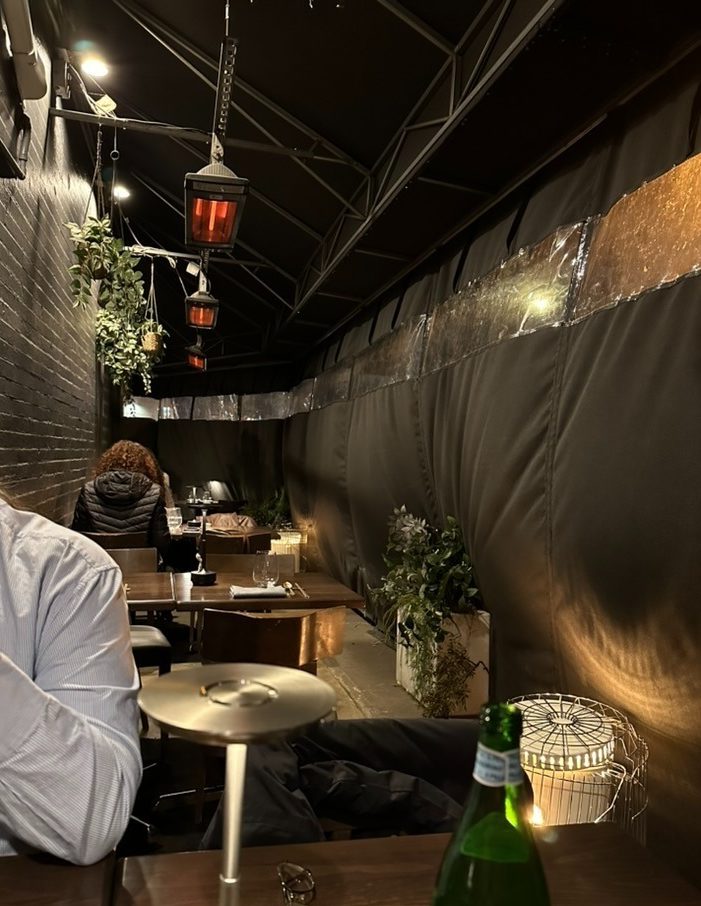
Kochi’s patio was, indeed, our first indication that the future of fine dining is not in fine surroundings. While the restaurant itself is pleasant enough – a contemporary, clean, non-distinctive, crowded space -, the patio itself was a sad afterthought. I imagine that it was put into place during the pandemic, but little to no effort has been added to make it a pleasant environment. The tenting and heating, while welcomed in such a cold, rainy night, were distinctively unattractive. More problematically, the smell from the fuel burnt by the heaters they used was overwhelming – I’m not sure if they had a leak or they use some particularly smelly fuel such as kerosene, but it smelled toxic. Given how important smell is to a culinary experience, this was an atrocious choice. At the prices they charge, they should be able to afford electric heaters.
On the plus side, Kochi is a rather casual restaurant, particularly in the patio, so you don’t have to worry about bringing a jacket for anything but warmth.
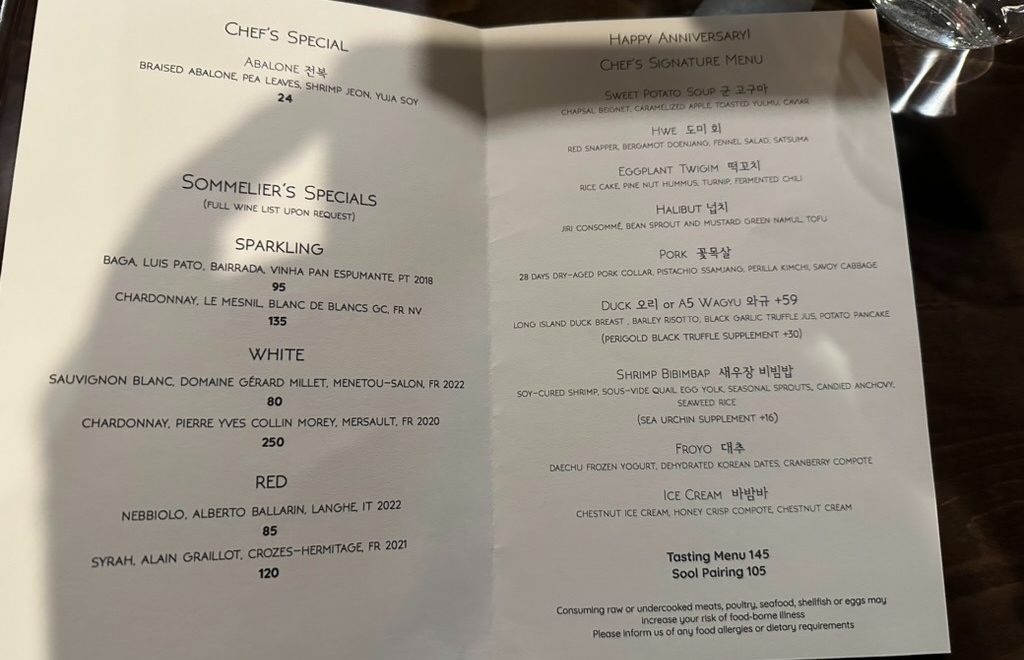
Kochi serves a 9-course menu for $145 plus supplements. The food is upgraded Korean street food, in particular, skewers – though a lot of the items they serve would be better off without one (do remove it before you try to eat each dish). While you don’t get to choose your courses, Kochi will text you before the evening and ask you about any food restrictions, and work around them. Everyone gets the same dishes. The amounts are perfect so that you don’t end up hungry, but are not overstuffed either. They offer a sool paring for $105, which consists of various Korean liquors. We decided against it, as we are not big alcohol drinkers. I had bubbly water while Mike had a single glass of sool, but he doesn’t remember which one. He found it interesting, but not something he’d have again.
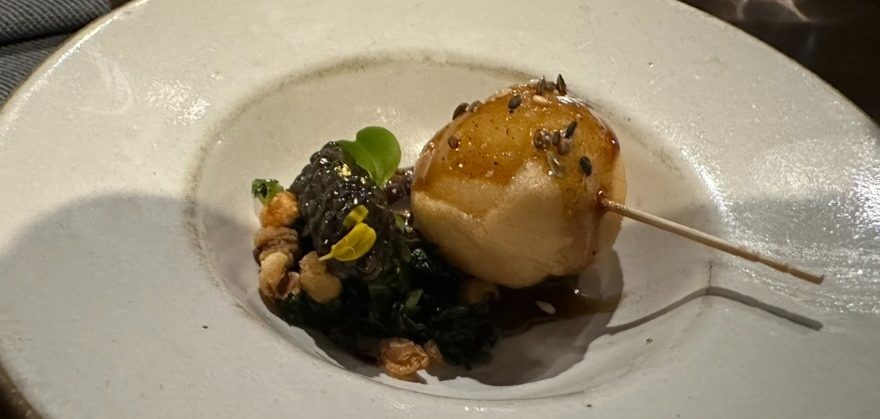
Dinner at Kochi started with Sweet Potato Soup (chapsal beignet, caramelized apple, toasted yulmu, caviar). The plate comes with the beignet and accoutrements, and the soup is poured on top of it (the photo was taken before that happened). The soup itself was absolutely delicious, and my favorite dish of the evening, and something I will try to make myself in the future. While the beignet and other ingredients added texture and contrasted well with the sweetness of the soup, the soup was really the star of this dish and didn’t need anything else.
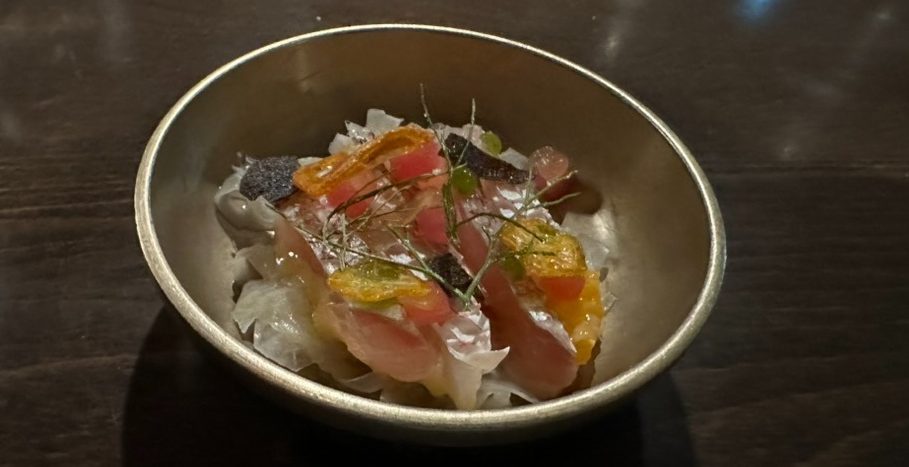
Our second dish was Hwe (red snapper, bergamot doenjang, fennel salad, satsuma). I’m not a huge fan of crudo, though I did like the fruitiness in this dish, but Mike absolutely loved this.
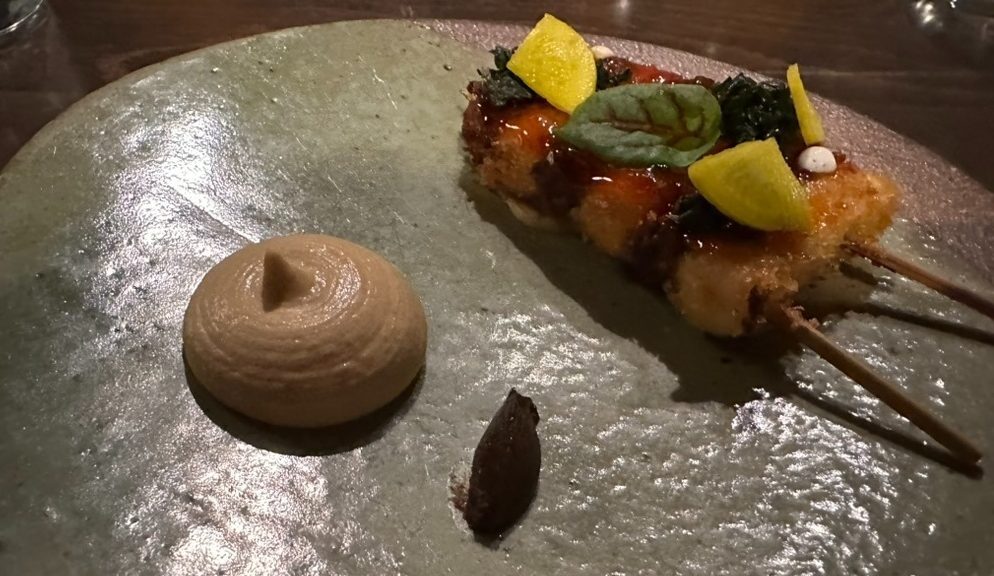
Next, we had the Eggplant Twigim (rice cake, pine nut hummus, turnip, fermented chili). Neither my husband nor I are fans of eggplant, but these skewers were surprisingly tasty. I did like the pine nuts hummus. In all, the combination of flavors and textures was quite good.
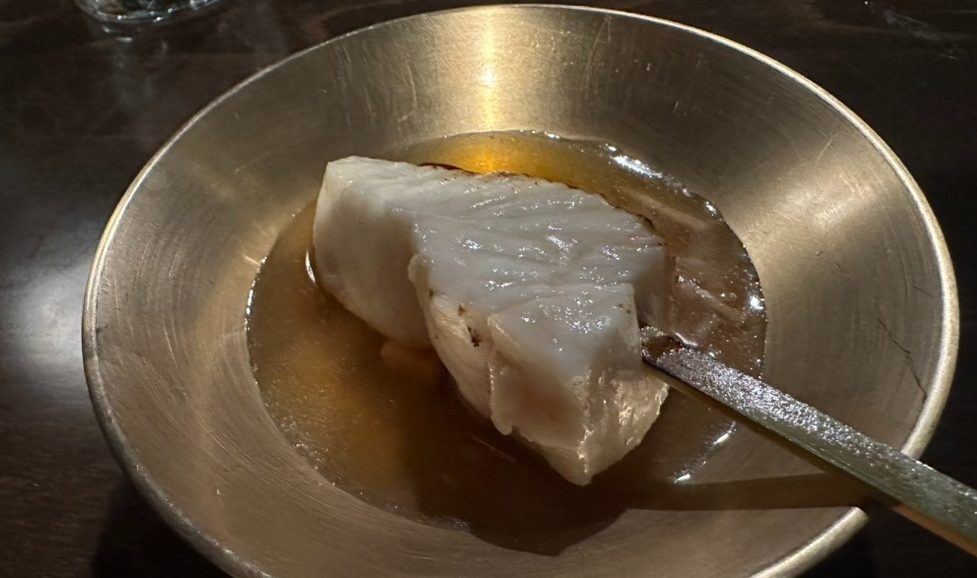
Our next skewer was of Halibut in a Jiri Consommé (bean sprout and mustard green namul, tofu). This bite was cooked to the precise right level of doneness, was wonderful flaky and nicely seasoned in the broth. Mike, who loves fish, enjoyed it greatly.
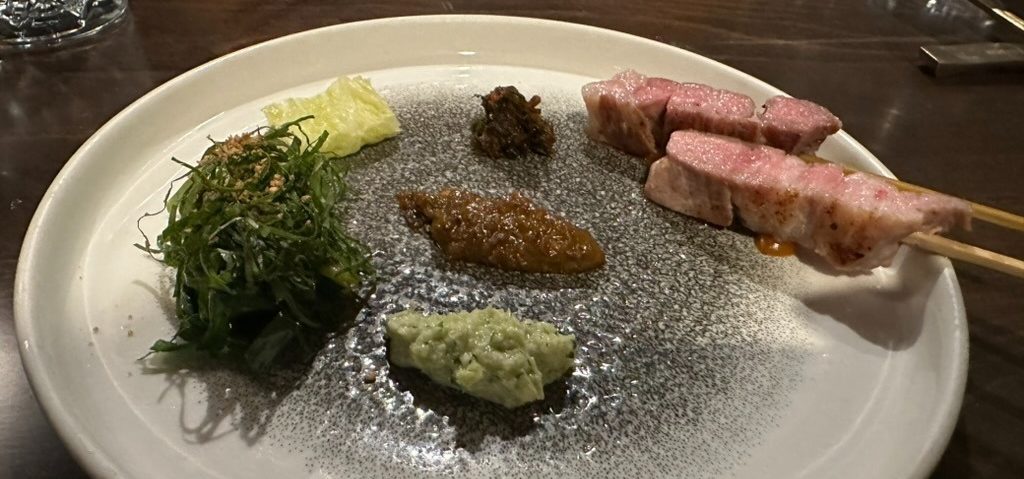
Next we had the 28 Days Dry-Aged Pork Collar (pistachio ssamjang, Perilla kimchi, Savoy cabbage). I’m sure it was good, but it was probably the least remarkable dish of the evening, as we can’t remember it at all.
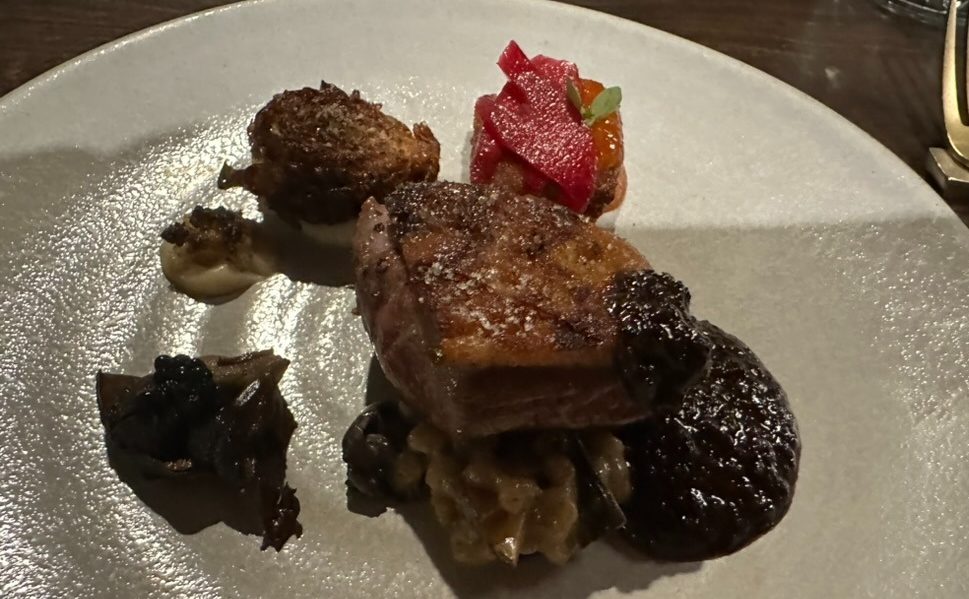
For the next dish, you could have the Duck (Long Island duck breast , barley risotto, duck jus, potato jeon) or substitute it with Wagyu beef for an extra charge. I decided on the duck, while my husband got the beef. It was perfectly cooked, the skin was nice and crispy, and the whole bite was delicious. I did like the combination of flavors, and the barley risotto underneath it.
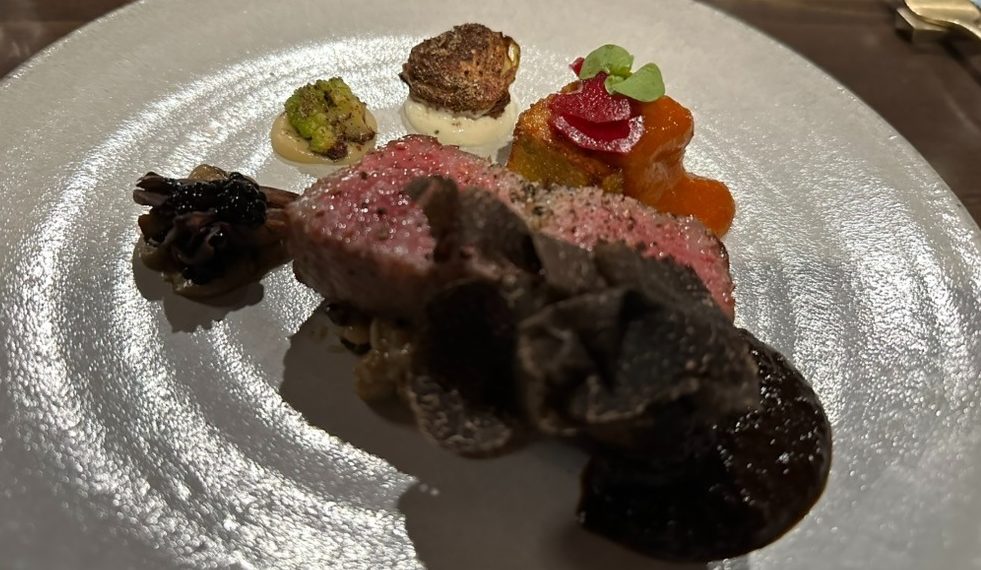
Mike loved his A5 Wagyu beef ($59 supplement), which came with the same accoutrements as the duck. While he opted against ordering the Perigord black truffle supplement ($20), it was served with it anyway, compliments of the Chef. A5 is the highest classification for Wagyu beef and you definitely could tell the difference. I’ve only had Wagyu beef twice (I’m not counting Wagyu beef patties), the first from a supermarket and the second at Bix in San Francisco, and neither could compare in any way whatsoever. Then again, a whole Wagyu steak at Bix was $50, while here you got a three-bite strip of beef for a $59 supplement. We did love it, but I don’t think it was worth the money – other than for the experience of having tasted such quality of meat. I wouldn’t order it again, unless I was swimming in money.

The last savory dish in the tasting menu is Shrimp Bibimbap (soy-cured shrimp, sous-vide quail egg yolk, seasonal sprouts, candied anchovy, seaweed rice). You can substitute the shrimp for sea urchin for $16. As I don’t eat shrimp, they offered to substitute the shrimp in this dish with salmon – which I dislike just as much. Fortunately, they were able to do substitute it with beef instead. Ultimately, I don’t think the meat made much of a difference, as it was only a small part of this dish – which really amounts to an after dinner salad. The flavors were quite nice, when everything is mixed together, and I think the crispiness of the fresh greens worked as a great counter for the fattiness of our previous course. This was quite well thought out.
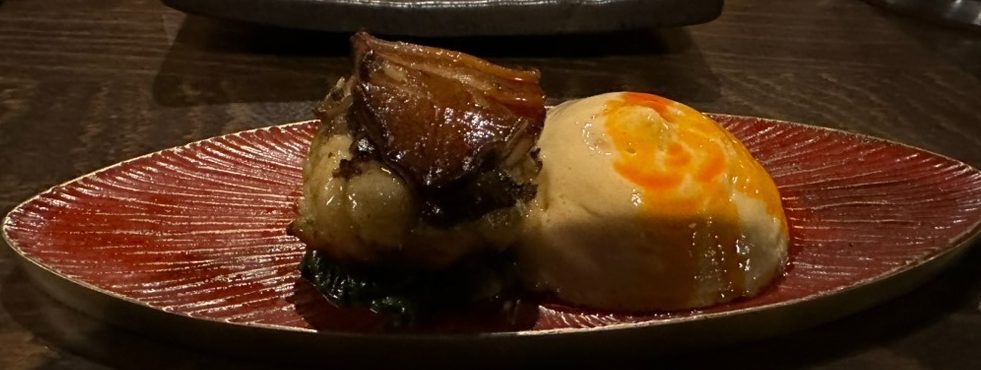
We had ordered one serving of the Abalone ($24 supplement), given that Mike wanted to try it and I didn’t (I did take a bite, I hated it as much as I thought I was going to). Unfortunately, they’d forgotten about it, and they only brought it when I reminded them. Fortunately this was before we had started our desserts. Mike was pleased though not overwhelmed by the abalone – which he’d never had before. He felt it tasted like he expects mollusks to taste, and he liked it but wasn’t overly impressed by it. He was happy to have tried it, but doesn’t think it was worth adding it, given the price.
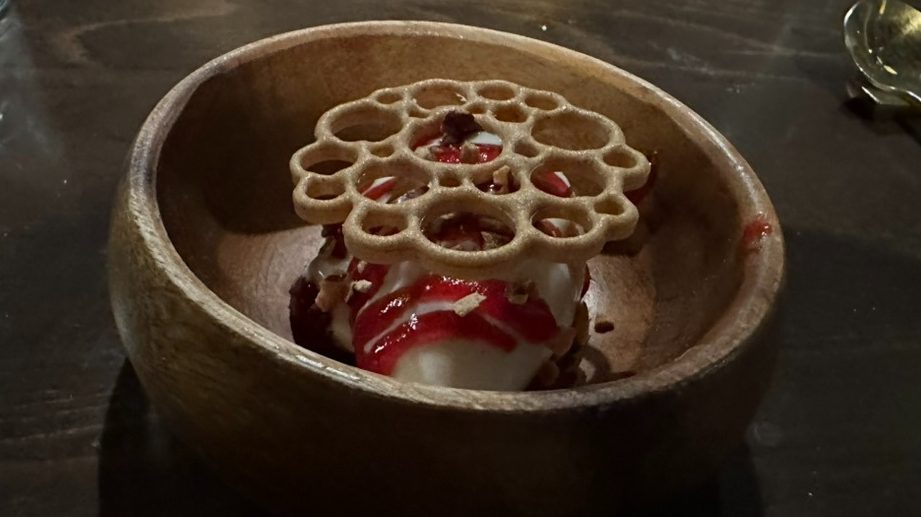
Finally, we had time for dessert – and this tasting menu includes two of them. The first was Froyo (daechu frozen yogurt, dehydrated korean dates, cranberry compote) and it was absolutely delicious. Mike liked it better than the plethora of desserts we’d had the previous night at Daniel, though I still preferred the vacherin there. But it was really, very good. I was dismayed when writing this review that daechu refers to jujube dates, which means that I will not be trying to make this frozen yogurt myself – but I really enjoyed the bright, tart flavor.
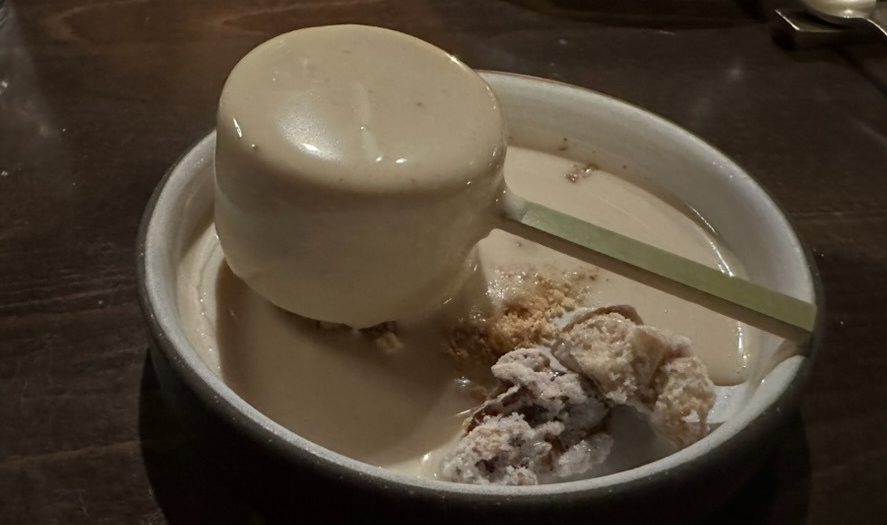
This was followed by Chestnut Ice Cream (honey crisp compote, chestnut cream). It was nice, but completely overshadowed by the froyo, which we liked fare more.
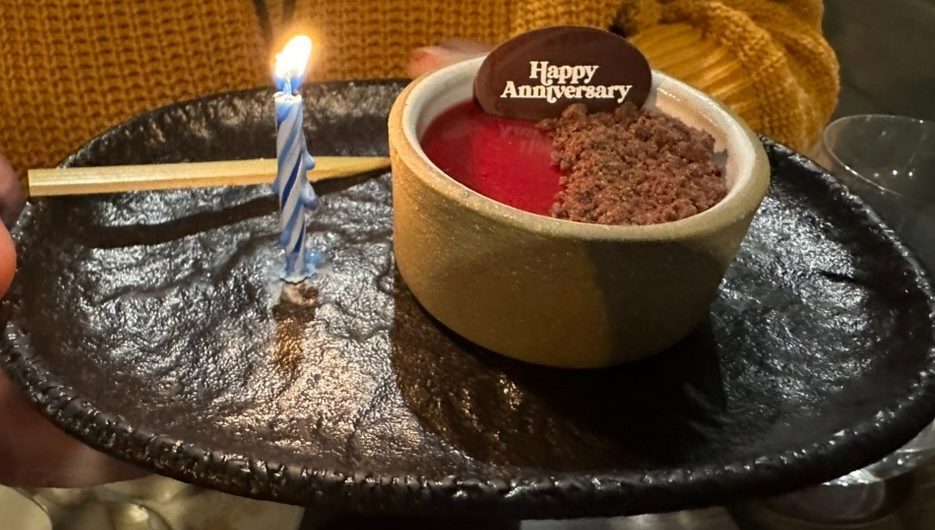
Finally, they brought us a complimentary dessert, as we were – once again – celebrating our anniversary (early). Unfortunately, I can’t remember it at all. If there is one thing I’ve learned from our two high-end dining experiences is that one dessert is enough. I understand that if you hire a pastry chef, you want to take full advantage of their talents – but at least at our age, we really don’t need that many sweets at the end of a meal.
Service was good and pleasant, but not particularly remarkable. It was definitely not as obsequious as at Daniel’s. In all, I’d say that dinner at Kochi was an excellent culinary experience – Mike actually liked the food better here than at Daniel’s -, the experience was limited to the menu. Beyond it, it was like dining at any other average restaurant. For the price – and we ended up spending roughly the same amount as at Daniels -, I felt dinner at Daniel was much more of a treat. Of course, if you can afford dinners like these as something other than once-in-a-decade experience, the lack of “specialness” about dinner at Kochi would probably matter far less.
Kochi 652 10th Ave. New York City 646-478-7308 Mon-Thur: 5:00pm – 9:30pm Fri, Sat: 5:00pm – 10:00pm Sun: 5:00pm – 9:30pm
Recent Comments